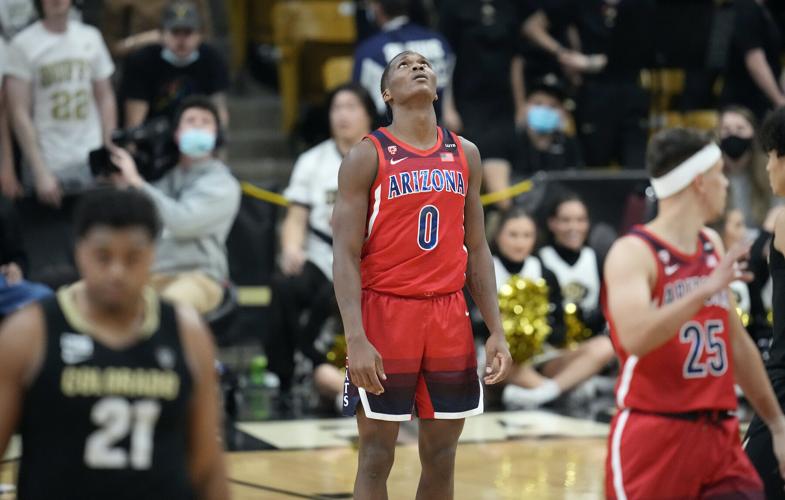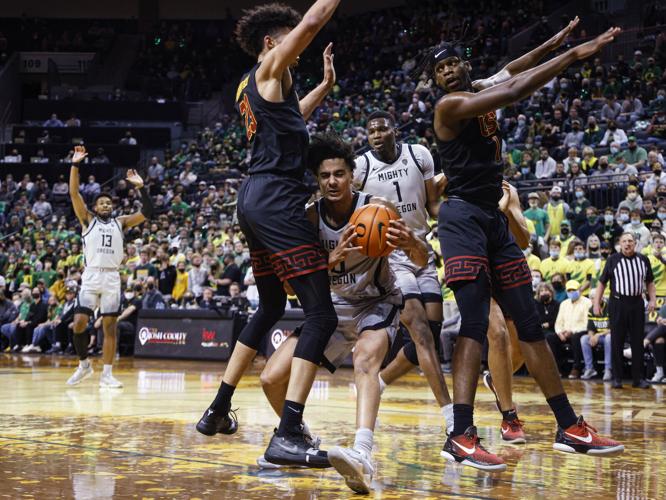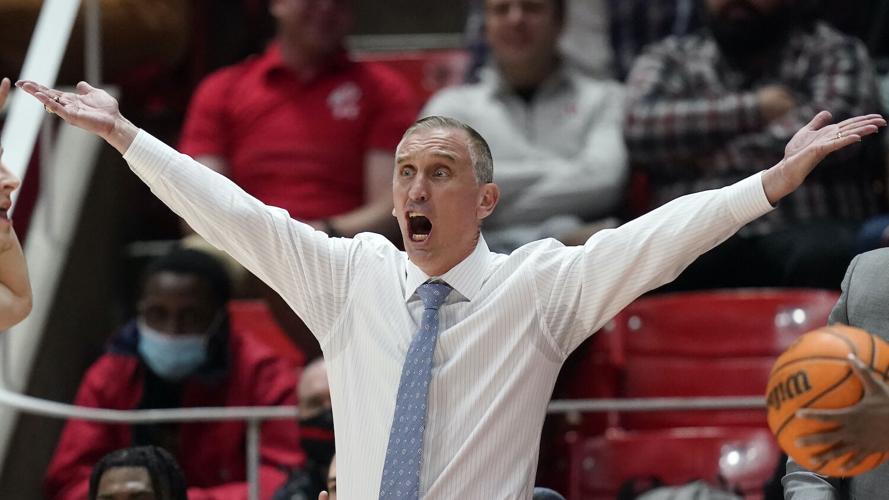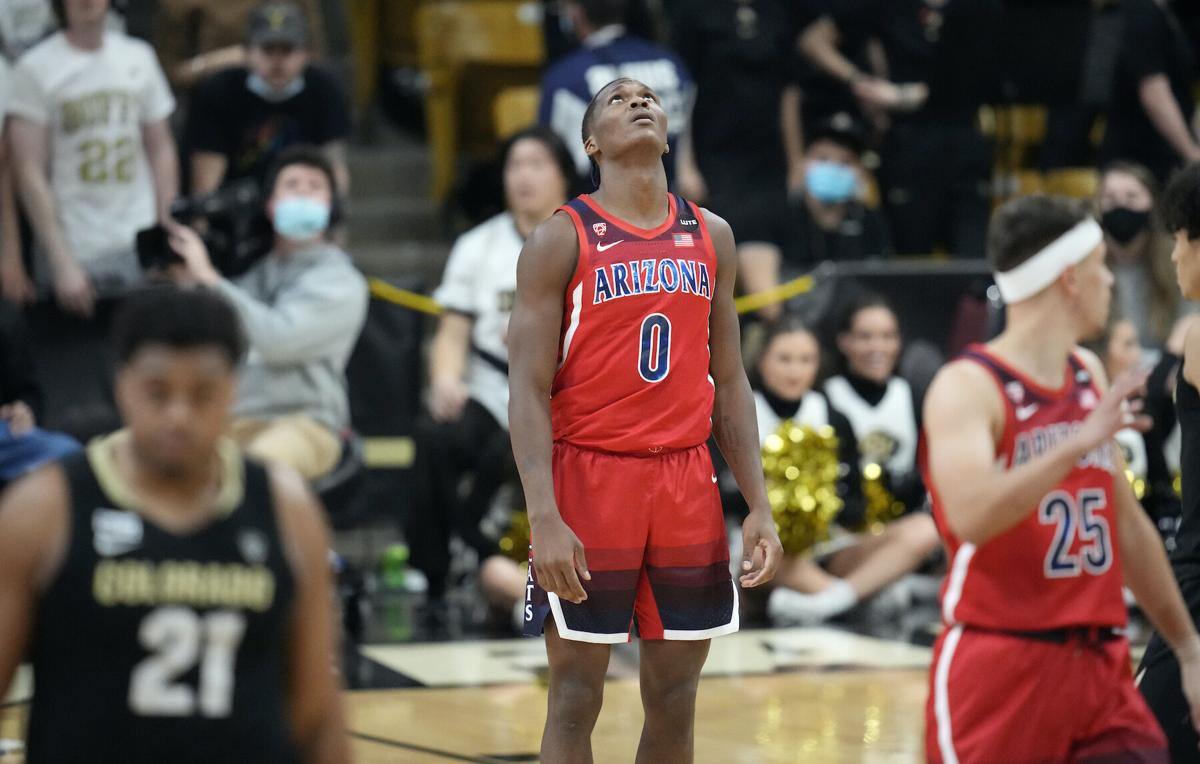What we learned on the penultimate weekend of the regular season …
1. Las Vegas could deliver drama, after all
Arizona, USC and UCLA have dominated the conference race since round-robin play ramped up in early January — to the point that the outcome of the Pac-12 tournament appeared entirely predictable:
The Wildcats would earn the No. 1 seed and roll into the championship game with the L.A. schools, seeded second and third, meeting in the semifinals.
But the results of the past four days suggest there’s a fleck of a prayer of a chance that the heavyweights might not advance as easily as expected at T-Mobile Arena (March 9-12).
- Arizona was defeated soundly at Colorado, looking more vulnerable than it has all season.
- UCLA lost at Oregon for its fourth defeat away from home in league play.
- USC needed double overtime to escape Corvallis and a last-second defensive stand to survive in Eugene.
Perhaps the quarterfinals and semifinals will be more interesting than we first thought.
2. The seeding situation remains murky
With one week left but a varying number of games remaining — some teams will play once; others, three times — none of the seeds for the conference tournament have been decided.
(Nope, not even Oregon State’s position as the No. 12.)
We could have clarity at the top soon: Arizona would clinch the regular-season title and No. 1 seed with a victory Tuesday at USC. But the situation in the middle of the standings is sure to remain muddled through the week.
If you’re attempting to sketch out the brackets for Las Vegas, remember that seeds are determined by winning percentage in conference play.
The first tiebreaker, of course, is head-to-head results.
If that doesn’t settle things, the second tiebreaker is winning percentage against “the common opponent occupying the highest position in the final regular season standings, and then continuing down through common opponents in the standings until one team gains an advantage” (per the conference office).
3. Arizona remains on the NCAA’s No. 1 line
The Wildcats were slotted atop the South region (San Antonio) last week in the early reveal of the top 16 seeds by the selection committee.
The loss at Colorado won’t change that status, especially after the top six teams in the AP poll all lost on Saturday (for the first time in history).
To remain on track for a No. 1 seed, Arizona probably cannot afford to lose at USC on Tuesday and suffer another loss in the Pac-12 tournament.
Slipping to the No. 2 seed line could result in the Wildcats being placed in the West region, where they would be scheduled to face No. 1 Gonzaga — coach Tommy Lloyd’s former team — in the Elite Eight.
4. Oregon remains on the NCAA bubble
Three teams are locks for March Madness (Arizona, USC and UCLA) while eight seemingly have been eliminated from the at-large pool and must win the Pac-12 tournament to claim the automatic berth.
The lone bubble team is Oregon, which helped its cause with a victory over UCLA but missed a chance to further its case with the one-point loss to USC.
We believe the Ducks have a good chance to sneak in, but they must beat the Washington schools this week, win their quarterfinal game in the Pac-12 tournament (at least) and receive help elsewhere.
Upsets in conference tournaments across the country would shrink the NCAA bubble and narrow Oregon’s path.

Oregon guard Will Richardson (0) collides with Southern California forward Max Agbonkpolo (23) in the first half of an NCAA college basketball game in Eugene, Ore., Saturday, Feb. 26, 2022. (AP Photo/Thomas Boyd)
5. Mike Hopkins’ job is safe
The Washington coach entered the season in precarious position after two ghastly seasons in Seattle. In our view, Hopkins didn’t need to reach the NCAA Tournament to save his job, but his program needed to show substantive progress.
The victory Saturday over Washington State was a major step in that direction, improving UW’s conference record to 9-8, with three games left: UCLA, Oregon and Oregon State — all at home.
In other words: As long as UW handles the lowly Beavers, it will secure a .500 season in Pac-12 play. That should be more than enough for Hopkins to return for Year Six.
6. Jerod Haase’s job is not safe
At precisely the wrong time, Stanford has produced one of the worst stretches of Haase’s six seasons in charge: After getting swept at home by the Mountain schools, the Cardinal managed just 39 points Saturday — 39! — in a double-digit loss at Cal.
(The 1950s called. They’re unimpressed.)
With five losses in his last six games, a trip to Arizona awaiting and no chance of an NCAA at-large berth, Haase has little to show for a tenure defined by mediocrity — and zero NCAA Tournament appearances.
7. Draw Arizona State at your peril
No team possesses more momentum than the Sun Devils, who have won five of their past six after a road sweep of the Mountain schools.
Two days before Arizona lost at Colorado, ASU ran the Buffaloes off the floor.
We see two primary reasons for the uptick in Tempe, and they’re connected: More efficient offense; and a regular rhythm of competition.
Because of COVID, the Sun Devils played one game in a 24-day stretch over the end of December and the first half of January. For a team that’s heavily reliant upon transfers, the shutdown severely impacted chemistry, confidence and rhythm.
ASU hosts the Bay Area schools this week, creating the distinct possibility that it will end the season with a .500 record in league play (10-10) — a remarkable turnaround for a team that was 3-9 at one point.

Arizona State head coach Bobby Hurley shouts during the second half of the team's NCAA college basketball game against Utah on Saturday, Feb. 26, 2022, in Salt Lake City. (AP Photo/Rick Bowmer)
8. USC’s shown grit
The Trojans built an impressive record (25-4, 14-4) on a soft non-conference schedule, a slew of narrow wins in league play and modest success outside the Galen Center.
It had been three months since their one and only road/neutral court victory over a team currently in position to reach the NCAA Tournament.
They beat San Diego State in Anaheim at the end of November, and that was it until Saturday night, when USC made a series of big plays on both ends of the court to repel the Ducks.
9. The not-so-secret to WSU’s success
Two games in four days against Washington — the duels featured the same score (78-70) but different winners — illuminated the Cougars’ chief challenge.
In the victory Wednesday in Pullman, forwards Mouhamed Gueye and Efe Abogidi combined for 46 points while guard Michael Flowers, the top scorer for the season, managed just 12.
In the loss in Seattle on Saturday, Flowers finished with 30 points but no one else scored more than 10.
To survive their opening-round game in the conference tournament — much less reach the semifinals or finals — the Cougars need balance to their attack.
10. Not-so-rocky road
USC and Arizona State recorded road sweeps this weekend, bringing to 12 the number of times a team has swept its two-game conference road swing.
That’s a record in the conference’s 12-school era, which began in 2011-12.
Interestingly, four teams have swept the Mountain trip (Oregon, ASU, USC and UCLA), which is typically one of the most difficult because of the altitude adjustment.







